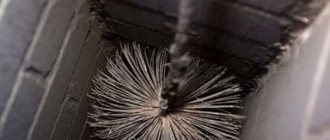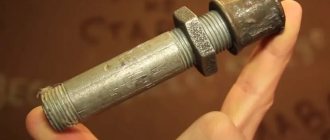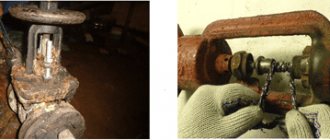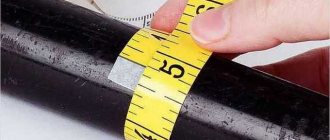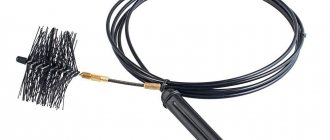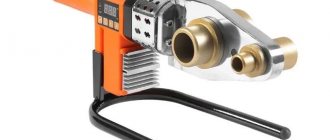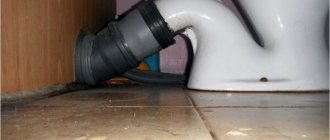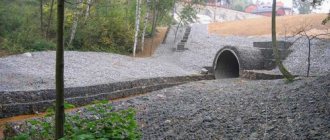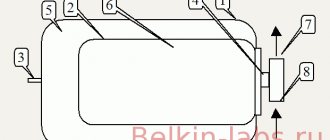How to find hidden water leaks?
Damage to plumbing, sewerage and heating systems, penetration of rainwater through roof defects, as well as leaks in the heated floor system can cause serious problems and subsequently costly repairs.
The trouble is that it can be extremely difficult to detect these problem areas at an early stage due to the fact that they are not always visually noticeable. The fact is that very often customers do not want to see pipes and other communications, so builders diligently hide them in screeds, walls and behind suspended ceilings. From an aesthetic point of view, everything is beautiful and convenient, but when it comes to finding problem areas with leaks, difficulties begin. Moisture oozes out of nowhere, and the owner, as a rule (in 90% of cases), does not have a plan for laying communications. What to do?
There is only one answer - you should order a thermal imaging inspection of your home. Only with the help of it will it be possible to detect places of hidden leaks absolutely painlessly for the interior decoration of rooms, and without wasting money on expensive repairs. In addition, based on the results of thermal imaging diagnostics, you can easily eliminate pipe leaks without opening the entire communication system. The benefits are obvious: saving time, saving money.
In addition to finding problems with pipes in the heating system, with the help of such an examination you can easily and quickly find leaks in a heated floor or a defect that appeared during production work, but for some reason was not detected during the process. Again, with the help of our latest equipment and qualified specialists, all defects can be identified quickly and locally. That is, you do not have to open all the floors and walls in order to eliminate a small leak. It will be enough to get to one problem area in which a leak was discovered.
How exactly does thermal imaging help detect hidden leaks? Everything is simple, and is due to the fact that the thermophysical properties of building materials are highly dependent on humidity. So, the higher the humidity, the higher the thermal conductivity of the material. For example, if there is a water leak in your floors, then the materials from which they are made have absorbed moisture, which means that heat passes through them faster, and the thermogram will immediately show this.
Thus, thermal imaging diagnostics is the most optimal solution for searching for hidden defects associated with water leaks. The thermal imager easily detects differences of hundredths of a degree, making hidden defects visible. As a rule, thermal imaging inspection, the purpose of which is to search for hidden leaks, takes place in several stages.
First, the room is inspected using a thermal imager to identify all problem areas. Due to its technical features, a thermal imager is the most effective device for searching for hidden leaks; what the human eye cannot detect, a thermal imager “sees” without problems.
And this is due to the fact that water accumulated in the walls (floors, etc.) cools or, conversely, heats all the materials surrounding it. A thermal imager easily detects such differences in temperatures, and all problem areas are indicated on thermograms.
The water contained in the materials will sooner or later begin to evaporate, absorbing the energy of its environment, thereby creating temperature changes. Typically, the difference between wet and dry areas is approximately 0.5 - 2 °C. This is a value that any professional thermal imager can easily detect.
So, first, all problem areas in the house are identified, and then a more detailed study of all areas with suspected defects takes place.
For a more clear example, let's look at a few thermograms. Below is a photograph and thermogram of a section of a water-heated floor. Using a thermal imager allows you to accurately determine the passage of communications.
So, red color indicates the highest temperature in this area (this is approximately 32.7°C). But let’s take into account that the layer of materials that make up the floor (these are tiles, tile adhesive and screed) is homogeneous in structure. Only a qualified thermal control specialist with extensive experience in such work can fully interpret what is shown on the thermogram of a heated floor: a pipe leak or another anomaly.
The thermal imager “saw” the difference between dry and wet materials, and displayed everything on a thermogram. Fast, simple, and without wasting your nerves. The leaking pipe has been found, and to fix the leak, you don’t need to break the entire floor; it’s enough to dismantle just one tile. The difference is obvious, isn't it?
The following thermogram shows us the heating system. Typically, pressure gauges are installed in buildings with autonomous heating. This gives at least a small opportunity to detect a problem with the pipes. If the pressure drops, it means the pipes are leaking.
But please note that the pressure gauge does not provide any accuracy. Yes, there is a leak in the pipes, but where exactly to look for it? Open all the walls? But this will damage the interior decoration of the room, which can be equated to a disaster.
This was the case before, but now non-destructive testing and combined leak detection methods will save you from expensive repairs and help eliminate all defects in the shortest possible time. We find the location of the pipe leak, and you eliminate all defects locally. There is no global damage to the interior finishing, the problem is solved.
Here are some more thermograms showing the procedure for finding leaks in heated floors. Visually nothing is visible in the photo, but the thermal imager shows that the pipe is leaking in this place.
Thus, recently, thermal imaging diagnostics of residential premises is the most convenient way to identify all pipe leaks (roofing, heating systems) in the house. Thermal imaging performed by specialists will help you understand where the leak is coming from, and most importantly, easily and quickly eliminate all problems.
You can ask any questions you are interested in and order a thermal imaging examination by calling (8452) 53-27-90. You can submit a request for a high-precision thermal imaging examination.
After receiving the application, our specialists will contact you to agree on the details.
stages
Look for puddles near the wall.
This is the easiest way to find out if water is leaking along the wall. You can be sure that water has entered the wall if you notice visibly damp carpet or if you notice that the floor is still damp in a certain area of the house.
- You're more likely to find wet floors in close proximity to appliances that use water (such as the washing machine and dishwasher) or in the bathroom near the sink, toilet, or shower. ,
Look for discoloration on the wall.
If water leaks into the wall, a slight discoloration will appear on the exterior surface over time. You should look for areas where the wall surface (wallpaper, drywall, or even wood) is slightly discolored or lighter than the surrounding area.
- It is likely that the appearance of discoloration is irregular.
Inspect the walls for changes in urine.
It is likely that leaking walls have a bubble-like shape. Paint or wallpaper will bend, tear, or bubble because water distorts its normal shape.
- If the drywall absorbs water, it will bow. If you find small bubbles or loose areas, this may also indicate the presence of water in the drywall.
- Walls with extended leaks may also be curved outward. Over time, the drywall will bend under the weight of the water that absorbs it.
Detect signs of fungus or mold.
If a wall leak has been going on for a long time, it is likely that mold will grow inside and on the surface. At first it appears as a dense group of brown or black spots. Even if you don't find mold, it may be growing inside walls that are soaked with water from a leak.
- Mold can cause allergies and other potentially serious health problems. If you find mold on the wall, remove it and fix the leak.
Beware of all musty odors.
In cases where the leak is not visible because it is behind a wall, you can detect it using your sense of smell. Since the water seeping into the walls has never had a chance to dry out, the walls will begin to emit a soft and damp smell.
- Walls with a musty odor are often accompanied by other signs of a leak (such as discoloration). However, this is not always the case. Sometimes the smell will be the only sign of a deep leak in the wall.
- Thick drywall can absorb water (almost like a sponge) and prevent signs of leaks from being detected.
How to find heat leaks in a house without a thermal imager
Autumn.
The time has come to carry out all the necessary work on caring for a wooden house, which you never got around to doing in the summer. After all, everyone wants their home to both look great and be technically prepared for the coming cold winter months. Nobody likes drafts and dampness. Autumn is the best time to identify places through which cold air can enter the house and eliminate any leaks of precious heat. Since fuel and electricity prices are rising all the time, this issue is also very relevant from an economic point of view. Even small gaps can cost you quite a bit of money. How to keep your house warm during winter? The key is to find and seal all heat leaks before the really cold weather arrives. How to insulate a house after the onset of frost - read HERE .
It is important to entrust the leak search to a competent specialist
When telling a client whether an area is wet or not, the thermal imager operator uses temperature as an argument rather than actual humidity levels. Some dishonest "experts" may take advantage of customers' inexperience by pointing out the color visuals displayed on the thermal imager's display. Images of wall sections with bricked-up cold water pipes and air ducts may give the impression that the area is damp when in fact it is only thermally cooler than surrounding areas. A “hot” spot on the route of a heating pipe located in a floor screed may not be a leak at all, but a coupling or outlet.
If the thermal imager is used incorrectly or if the owner of the apartment is deliberately misled, the images on the screen of the thermal imager can lead to false conclusions and unnecessary repair work. However, when it comes to positioning yourself as a leak detection expert, a thermal imager and the visuals it provides can demonstrate to a homeowner or business owner that using this advanced technology is a sign of professionalism.
If used correctly, a thermal imager can be one of the excellent tools used when searching for leaks. But remember that this is only a tool and should always be used in conjunction with other instruments, such as moisture meters and leak detectors, to ensure that the anomaly detected by the thermal imager is in fact a leak. A competent leak specialist will use a moisture detection tool to find out the true picture of moisture intrusion and confirm or refute the leak results obtained by the thermal camera.
Equipment used by SES workers
Inspecting pipes with a thermal imager
Experts use the most effective methods. Considerable experience allows craftsmen to find pipe defects in difficult conditions. Then, based on the test results, write a conclusion and act for presentation to higher authorities, including the court.
To get effective results, we use different techniques and devices:
- Thermal imagers with high resolution and high-contrast matrices. Such devices are expensive, but inexpensive models may not detect a leak.
- Humidity scanner. Determines the moisture content of building materials.
- Path-defect detector. To find hidden communications.
In addition to these devices, we use an air compressor, an ultrasonic leak detector, an endoscope and other devices. We have the equipment to solve the most complex problems.
About the danger of leaks
A leak is one of the most annoying plumbing problems. Sometimes it can be determined visually when water gushes out from under the ground like a fountain, but there are times when this is impossible. To eliminate an accident, it must first be accurately detected.
Previously, to determine a leak, people had to dig up the ground in the suspected area of the accident, but this did not always bring the expected results. These events are not only labor-intensive, but also cause a lot of trouble for others - long-term water supply outages, blocked roads, etc.
Sometimes the leak is so small that no one even knows about it. To fix such a breakdown, you need to spend a lot of time and effort.
A slight drop in pressure in the system is the first sign that not everything is in order on our line. Over time, this will develop into a serious leak, and therefore it is necessary to take measures to eliminate it as early as possible.
Methods for determining leaks
There may be several options for determining leak locations:
Correlation leak detector
- If metal pipes are used, the water pipe break is located using a signal generator. It is installed on the highway and sends a signal that is picked up by the receiver. Nowadays, mainly plastic systems are used, so this method is of little relevance.
- You can fill the line with a mixture of safe gas. Typically it is 95% nitrogen and 5% hydrogen. Gas will escape from the crack, penetrate the layer of soil, asphalt or concrete and come to the surface. From above, this leak is detected by gas analyzers, which determine the damage.
- You can detect a water pipe break using two cylinders. They are inserted into the area being tested from both sides. Air is forced into the pipe. If the pressure drops - the damage in the area between the cylinders remains unchanged - the next section is checked.
- You can also use a special device - a leak detector. Regardless of the conditions of the pipes, this device determines the leak with an accuracy of 1 m to 10 cm.
What to do next?
After diagnosing the location of a water leak in a pipe in an apartment or private house, it is necessary to somehow solve the problem. If you live in a private house, then block the leaking branch and call the experts who will eliminate the leak with minimal damage.
Please note that repairing metal-plastic pipes using standard fittings is quick and easy; pressing in the coupling will take a few minutes. The replaced joints with new ones are unlikely to start leaking. Professional builders try not to embed metal connections into walls or under floors and leave them accessible. The nuts on them have to be periodically tightened, especially on hot water circulation circuits, to carry out a so-called inspection. However, if this is not done and a leak occurs, do not despair, there is no need to break anything. It’s the 21st century, all problems have long been solved in a matter of minutes!
If plumbers with old thinking and vlads advise to change the entire pipe, break it here, and we’ll see there - you don’t need to do this, just call us! It’s easier with metal pipes - just apply a clamp or weld. In multi-storey buildings the situation is more complicated - you may have to shut off the entire riser and look for a specialist from a local service company. But for diagnostics with a thermal imager, you don’t need to block anything; there should be a leak at the time of inspection. You simply call in an emergency.
Thermogram 3. The exact location of the hidden depressurization of the heating line was determined at the corner joint in the floor screed at a depth of 10 cm.
Thermogram 4. The exact location of the hidden depressurization of the hot water supply line at the welded corner joint located in the floor screed was determined.
How to find a water leak? Why are hidden leaks dangerous?
Causes of water leakage
Quite often, many people do not decide to replace old water pipes, based on the fact that the upcoming work will be quite expensive and quite difficult to carry out. Others rely only on their own experience and try to replace damaged pipes on their own. But such work may not always be crowned with success. Basically, the process of replacing water pipes requires the use of specialized tools, as well as work experience.
Old water pipes, which have served for decades without proper repair, in most cases become clogged with rust, slag and other deposits. Inside the pipe there is only a small gap through which the flow of water passes, as a result of which the pressure in the pipe decreases.
There is also another problem associated with the appearance of rust on old pipes. Subsequently, holes are formed from which water begins to flow. In such places, the pipe wall becomes quite thin and, unable to withstand the pressure of water, bursts. These places are quite dangerous and extremely vulnerable. Such pipes can burst at any moment and flood your apartment, and with it your neighbors.
It is also possible that pipes can burst after the water in the systems freezes, and you will only be able to detect such breaks in the spring, when the weather outside is relatively warm. In this case, ice forms first on the walls of the pipe, and then grows along the radius until the pipe is completely covered with an ice plug. The formation of such a plug leads to a rapid increase in pressure in the pipe, causing it to burst.
It is worth noting that hot water pipes rupture more often due to a sharp temperature change in the main line.
Threats of water leaks
Such unexpected leaks and breaks in water pipes lead to:
- damage to your property;
- and can significantly affect your family budget.
The most dangerous of these factors for human health is the occurrence of mold. By spending a lot of time in rooms with high dampness, each of you risks your health.
The human condition is adversely affected by pathogenic spores of mold and fungus, which “feel” well in high humidity. As a rule, the foci of such bacteria are based in places with high humidity, respectively, also near places of pipe leakage. The spores enter the human body through the respiratory tract, being absorbed into the blood. Next, they destroy beneficial bacteria and suppress the immune system.
In addition, mold also literally “eats” building materials and affects their quality. Thus, you will need to not only take care of solving problems related to your health, but also carry out repairs in this room, as well as think about replacing the pipeline, if this is what caused the emergence of pathogenic bacteria.
Dealing with mold is quite difficult - both at the level of treating your health and at the level of the repairs done. No medicine can help you in this case until you eliminate the cause of mold and mildew. In this case, you will need to correctly determine the cause of the appearance of pockets of pathogenic bacteria and eliminate it.
There are special products that help in the fight against mold and mildew, but finding a universal solution is quite difficult. Without actually trying several products, you will not be able to determine the most suitable option for you. The best solution in this case would be to periodically diagnose the water supply system for hidden leaks and timely correct any problems that arise in its operation.
Special attention should be paid to the destruction of the foundation and brickwork in houses (sometimes this also happens in apartments). Hidden leaks in this case symbolize those holes, corrosion or cracks that form in the pipeline. In this case, the water does not immediately come out, but travels underground, washing its way up to several tens of meters in some cases.
Thus, water enters the brick or concrete (depending on what material the house is built from), saturates it, and when the ambient temperatures reach sub-zero temperatures, it freezes and then tears the material from the inside. It is worth noting that wet materials also release heat faster, i.e. wet walls in the house will be colder than dry ones.
How to Find a Hidden Leak
Sometimes such leaks practically do not manifest themselves and are invisible to the human eye. They can be determined by indirect signs, such as a drop in pressure in the boiler or wetness of any sections of the wall or ceiling. At first glance, this may seem like a fairly simple problem, but it will last until the leak manifests itself 100%. As noted earlier, pipe leaks are dangerous due to subsidence or complete destruction of the foundation due to soil erosion.
Finding water leaks should be done using specialized equipment. But in some cases you can do without a complex tool. The initial inspection at objects with suspected leaks is carried out visually, inspecting problem areas. Small or hidden leaks can be difficult to visualize. An initial inspection of problems can only be performed in case of severe leaks.
Also in their work, specialists use the method of detecting hidden leaks using building material moisture meters that measure the moisture content of brick, concrete, screed, foundation and other building materials at different depths from 10 to 300 mm.
Most often in construction, special construction moisture meters of conductometric and dielcometric types are used. These are devices that are small devices for measuring the moisture level of materials for both indoor and outdoor use. They are quite easy to use. You can buy a moisture meter for building materials on our website pragmatic.com.ua. Our team of specialists will help you choose the best option for you.
An alternative way to identify problem areas in a pipeline is to use a device such as an acoustic water leak detector. These devices are capable of localizing the location of a leak with high accuracy. When water leaks, it creates ultrasound that is not perceived by the human ear. The leak detector picks up this sound thanks to an ultra-sensitive microphone and reproduces it through headphones. Thus, the stronger the sound, the closer the leak is. And to search for leaks in underground communications, in addition to a microphone (geophone), a formation gas is used, which includes hydrogen (H2). Hydrogen is pumped into the pipe system. Due to the fact that hydrogen is the lightest gas, it flows out of the pipe crack along with water and is captured by the chemical sensor of the leak detector.
What areas and elements can leak?
Leaks are most common in metal pipes. Elements that may be subject to destruction are the following:
- joints of pipes, adapters and seams;
- solid pipe;
- radiator;
- under the locknut;
- in the heated floor circuit;
- space between battery sections.
Leaks in the heating system often occur in radiators.
Most often, cheap polymer pipes are susceptible to damage. They break, leak, swell. Metal-plastic pipes are also susceptible to leaks if they were incorrectly selected. There are special products for heating systems. If pipes for cold water are installed in it, then under the influence of high temperatures they become deformed and burst.
Operating principle of the GIDROLOCK CONTROL system.
The GIDROLOCK CONTROL system uses a method to control and protect a closed heating system from leaks by constantly comparing the amount of water (coolant) at the inlet and outlet of the heated room(s). The control unit of the protection system constantly monitors the status of flow meters installed respectively at the inlet and outlet of the heating system. If a leak occurs, these readings will differ and if the difference in the readings increases above a specified level, the control unit will issue a command to close the electric ball drives. If an emergency occurs in the heating system, the supply of coolant to it will be stopped automatically and an audible alarm will sound. This way you can avoid large material losses that always accompany accidents in the heating system. System reliability is increased by implementing the principle of uninterrupted operation. For this purpose, a battery is included in the system. It ensures the operation of flow meters, control unit and ball electric drives, even in the absence of power supply in the protected premises.
The heating protection system includes:
● Two ball electric drives installed respectively at the input and output of the closed heating system of the room(s).
● A control unit that implements automatic operation of the system.
● Two flow meters installed respectively at the inlet and outlet of the closed heating system of the room(s).
How to find a leak in a wall
70% of the housing stock in Russia was built in Soviet times, so wear and tear of communications in apartment buildings is a frequent and widespread occurrence. But new buildings are not immune from force majeure situations. Let's figure out what to do if a pipe in the interfloor ceiling bursts and who will compensate the owners of the affected apartments for damages.
About the situation in general
When water runs from the ceiling or along the wall in an apartment, the first thing residents do is go up to their neighbors above. This is obvious and, in general, correct. But if on the floor above everything is dry and there are no signs of leaks, then the problem is in the communications laid in the interfloor ceilings.
Sewer pipes, heating pipes, and risers can leak. The exact reason will be determined by specialists from the management company. And then there are two possible options for the development of the situation.
The management company works only with the damaged apartment. It is possible to eliminate the leak through the ceiling (wall). Two parties are “sorting things out” - the owner and the management company.
Communications can only be accessed through the apartment above. To do this, they raise the floor or dismantle the wall. This means that a third party is already involved in the case.
And the second option always raises many more questions than the first. This is understandable. Residents on the floor above, where everything is visually in order, do not want to disturb their comfort and make unplanned repairs. It’s even worse if the repairs have just been completed and “everything will happen all over again.”
What do the owners of both apartments need to know?
According to Decree of the Government of the Russian Federation No. 491 of August 13, 2006, communications located in the floors of a house between floors, basements, and technical rooms are classified as common property. The management company is responsible for their condition, repair and replacement. The installation of new pipes to replace faulty ones is undertaken by the management company.
However, residents are also interested in other questions - who will do the repairs directly in the apartments and who will compensate for the damage? Let us turn again to legal acts. If the management company is responsible for the leak, that is, found guilty, then it must compensate for the damage caused. This is confirmed on a general basis by the Civil Code of the Russian Federation, Article 1064.
To replace pipes in ceilings, workers need access to communications. Owners are obliged to provide this access, regardless of their desire or unwillingness. Otherwise, which is not uncommon for a situation with an apartment above, the management company files a lawsuit. If the judge decides to allow repairmen into the apartment, then the owner does not have the right to interfere. He has the right to make material claims against the management company upon completion of the repair work.
To receive compensation for work in an apartment, the owner must:
- Record the location of the leak that caused the flood (to prove that this is common property)
- Receive a certificate of completion of work from the management company
- Assess the damage (invite an independent appraiser, conduct an examination)
You can confirm material claims in another way - by providing receipts for building materials and an agreement with the repair team indicating the amount that has been saved since the last repair in the apartment. This is especially true when the renovation is new.
The management company is obliged to compensate for damage within 30 days. If compensation is not received, a claim is filed in court.
Controversial case
It happens that neighbors from the lower floor follow the principle, refuse to contact the management company and demand money from the upper apartment. Moreover, the amounts are inflated several times. There is only one way out - to start an official investigation and prove in court who owns the leaking pipe, who monitors the condition of this area and is obliged to reimburse the monetary costs for repairing communications and premises.
